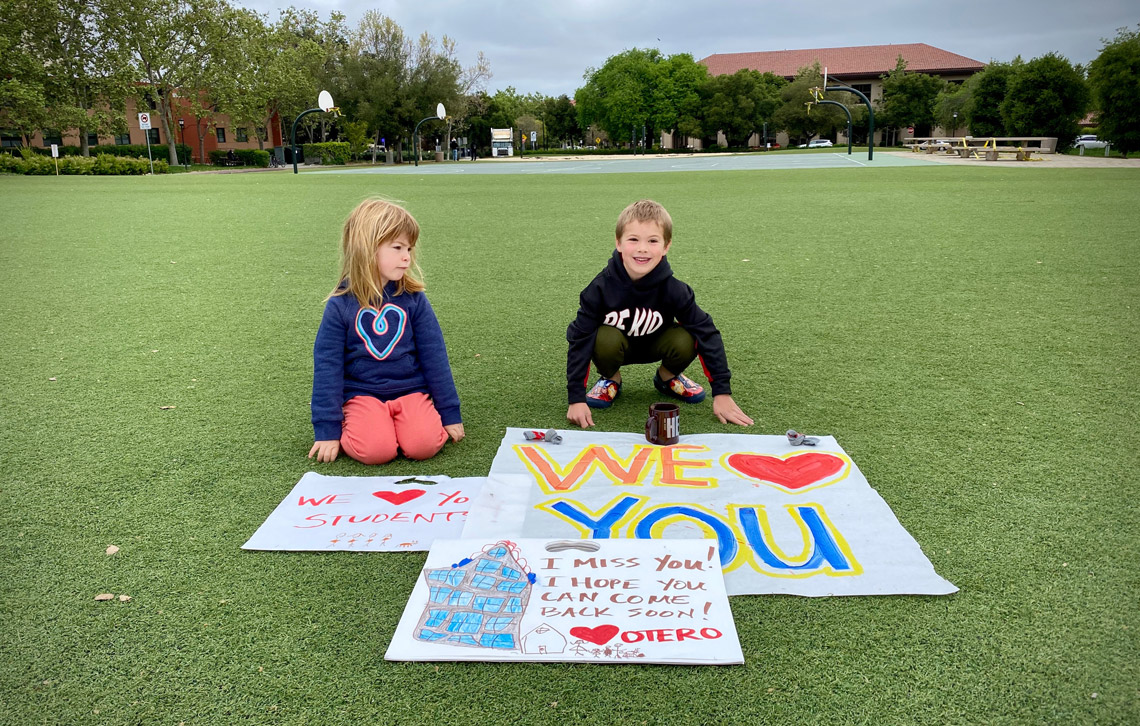
Campus right now.
Provost Persis Drell, along with other university leaders, laid out possible scenarios for the reopening of campus for the upcoming academic year, stressing that 2020–21 will be “a year of change and adaptation.” While no final decisions have been made, Drell did narrow the range of what students can expect. Undergraduate instruction “at the extremes”—fully on campus and in person in the fall or delayed entirely until later in the year—are the least likely of the scenarios under consideration. Graduate students are likely to have hybrid in-person and remote instruction.
The effects of COVID-19 continue to be felt across the student community. Stanford reassured those applying for 2021–22 that any pandemic-related disruptions or changes in their education will not affect admissions. As for June 2020 graduates, President Marc Tessier-Lavigne announced a livestreamed experience to celebrate their milestones (an in-person Commencement will be planned for a future date). Alumni can get involved by participating in a video message to the Class of 2020.
Testing our patients.
Why is it taking so long to develop a COVID-19 vaccine? Well, it isn’t—it just seems that way. Seema Yasmin, director of the Stanford Health Communication Initiative, explains that vaccine development happens in several stages, and each stage has a variable timeline that can’t really be rushed. “Here’s a comparison. The fastest vaccine we previously developed was for mumps, and that took four years to develop. And typically it takes 10 to 15 years to develop a vaccine. So 12 to 18 months would be record-breaking,” she told WIRED.
Testing for Covid-19 antibodies continues at Stanford Medicine in an effort to determine the extent of infection in the Bay Area. In this behind-the-scenes video, the New York Times followed two Stanford Health Care workers as they went through the antibody testing process. And Stanford researchers are working on a saliva test that could make diagnosing the disease cheaper, safer and more accessible if the test proves to be as accurate as the current gold standard, the nasal swab test.
An Olympian, a magician and a photographer walk into a Zoom.
Learn how to exercise in confined spaces with Olympic softball player and ESPN broadcaster Jessica Mendoza, ’02, MA ’03, and how to join two ropes together with magician Andrew Evans, MS ’13. These are the latest episodes of STANFORD magazine’s Nothing Better to Do video series, in which alums whose jobs involve performing, broadcasting and creating share their expertise.
Love notes from the Farm.

Cora and Wyatt Patton, who live in Otero with their Resident Fellow parents Ben, ’03, and Jill Redhage Patton, ’03, MA ’04, took to Wilbur Field to send messages to Otero residents, now scattered around the world. Other RF families and pets got in on the project as well.
Photo credit: Ben Patton, ’03
This quarantine is cosmic.
Scott Hubbard, adjunct professor of aeronautics and astronautics and a former director of the NASA Ames Research Center, is a co-author of a report, written before the current pandemic, that outlines recommendations for protecting Earth and other planets from biological cross-contamination. This is something scientists have had concerns about since the earliest days of space exploration. Today, with Elon Musk’s Tesla Roadster rocketing around the sun and more international and private-sector space travel on the horizon, the report urges oversight to prevent who knows what kind of contagions from hitching a ride in either direction.
But wait, there’s more.
Wearing a tight-fitting mask can feel stifling, which may trigger anxiety in some people. If you have to take yours off when you’re out, here’s how to do it safely. Hint: Start with clean hands, and have a way to store your mask safely while you’re taking a breather. “A brown paper sandwich bag is probably a good idea to keep with you, because it’s porous,” says Stanford Health Care’s Anne Liu.
You probably don’t need to worry about getting stung by a murder hornet. The greater danger is the threat they pose to the U.S. honeybee population, say scientists at Stanford’s Natural Capital Project.
When undergrads had to leave campus, some international students faced complications. Here’s what stay-home orders look like for six of them.
We have a model for how to safely lift the lockdown, Atul Gawande, ’87, writes in the New Yorker. Health care has figured out how employees can work with one another and the public without spreading the virus.
Masks, quarantine, temperature checks. Sound familiar? We’re talking about when the 1918 flu came to Stanford.
Can we save the world wearing pajama pants? Kathy Zonana, ’93, JD ’96, and Summer Moore Batte, ’99, continue their quarantine kvetching with a bidet, internet outages and a hierarchy of sweatpants.
Sandstone brick by sandstone brick: Students have been re-creating the Stanford campus on a Minecraft server.
Distance learning was its own special brand of hell. But what happens when school’s out and there’s just . . . nothing? Here are 20 ways to keep kids learning this summer, including advice from Stanford’s Development and Research in Early Math Education network on incorporating math lessons into activities like baking and cleaning.
Summer Moore Batte, ’99, is the editor of Stanfordmag.org. Email her at summerm@stanford.edu.
Note: The Loop sometimes links to articles outside of Stanford that may require a subscription to view.


